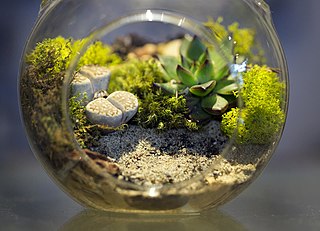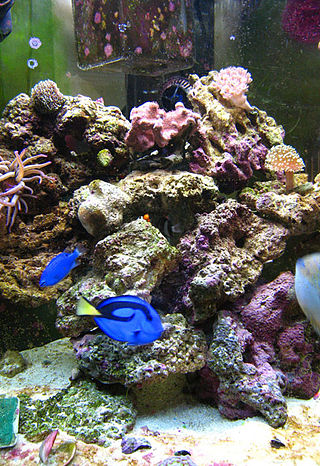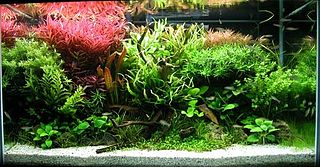Related Research Articles

Isopoda is an order of crustacean, which includes woodlice and their relatives. Members of this group are called Isopods and include both terrestrial and aquatic species. All have rigid, segmented exoskeletons, two pairs of antennae, seven pairs of jointed limbs on the thorax, and five pairs of branching appendages on the abdomen that are used in respiration. Females brood their young in a pouch under their thorax.

A vivarium is an area, usually enclosed, for keeping and raising animals or plants for observation or research. Water-based vivaria may have open tops providing they are not connected to other water bodies. An animal enclosure is considered a vivarium only if it provides quality of life through naturalistic components such as ample living space and natural decor that allow and encourage natural behaviours. Often, a portion of the ecosystem for a particular species is simulated on a smaller scale, with controls for environmental conditions such as temperature, humidity and light.

The EcoSphere and "Original Ecosphere" are trademark names for sealed blown-glass miniature aquaria formerly produced by Ecosphere Associates, Inc., of Tucson, Arizona, United States. Spherical or ovoid, the aquaria range from roughly pool-ball-size to basket-ball-size. They are sold worldwide as scientific novelties and decorative objects.

A marine aquarium is an aquarium that keeps marine plants and animals in a contained environment. Marine aquaria are further subdivided by hobbyists into fish only (FO), fish only with live rock (FOWLR), and reef aquaria. Fish only tanks often showcase large or aggressive marine fish species and generally rely on mechanical and chemical filtration. FOWLR and reef tanks use live rock, a material composed of coral skeletons harboring beneficial nitrogen waste metabolizing bacteria, as a means of more natural biological filtration.

Aquascaping is the craft of arranging aquatic plants, as well as rocks, stones, cavework, or driftwood, in an aesthetically pleasing manner within an aquarium—in effect, gardening under water. Aquascape designs include a number of distinct styles, including the garden-like Dutch style and the Japanese-inspired nature style. Typically, an aquascape houses fish as well as plants, although it is possible to create an aquascape with plants only, or with rockwork or other hardscape and no plants.

The halloween hermit crab, also known as the striped hermit crab or orange-legged hermit crab, is a brightly colored aquatic hermit crab of the family Diogenidae. Besides its ability to routinely clean algae in aquaria, the halloween hermit crab's festive striped coloration also appeals to enthusiasts; it is considered the most brightly colored hermit crab in normal aquarium use.
A deep sand bed is a filtration method used in some saltwater aquariums and some freshwater aquariums. A deep sand bed, similar to the Berlin Method, is designed to cultivate anaerobic bacteria in the bottom layers of sand, converting nitrate to nitrogen gas to remove toxic nitrates.
Algae eater or algivore is a common name for any bottom-dwelling or filter-feeding aquatic animal species that specialize in feeding on algae and phytoplanktons. Algae eaters are important for the fishkeeping hobby and many are commonly kept by aquarium hobbyists to improve water quality. They are also important primary consumers that relay the biomass and energy from photosynthetic autotrophes up into the food web, as well as protecting the aquatic ecosystem against algae blooms.

Ogcocephalus vespertilio, the Brazilian batfish or seadevil, is a species of batfish. Its distribution includes the western Atlantic, from the Antilles to Brazil, more specifically on the coast of Brazil, occurring from the Amazon River to La Plata River This species grows to a length of 30.5 centimetres (12.0 in) TL.

Notomithrax ursus, known as the hairy seaweed crab, is a spider crab of the family Majidae.

In fishkeeping, a refugium is an appendage to a marine, brackish, or freshwater fish tank that shares the same water supply. It is a separate sump, connected to the main show tank. It is a "refugium" in the sense that it permits organisms to be maintained that would not survive in the main system, whether food animals, anaerobic denitrifying bacteria, or photosynthesizers. For some applications water flow is limited in order to protect plants or animals that require slow flow. The refugium light cycle can be operated opposite to the main tank, in order to keep total system pH more stable (due to the uptake of acid-forming CO2 by photosynthesis occurring in the refugium during its "daylight" hours). One volume guideline for a refugium is 1:10 main tank volume.

A bottom feeder is an aquatic animal that feeds on or near the bottom of a body of water. Biologists often use the terms benthos—particularly for invertebrates such as shellfish, crabs, crayfish, sea anemones, starfish, snails, bristleworms and sea cucumbers—and benthivore or benthivorous, for fish and invertebrates that feed on material from the bottom. However the term benthos includes all aquatic life that lives on or near the bottom, which means it also includes non-animals, such as plants and algae. Biologists also use specific terms that refer to bottom feeding fish, such as demersal fish, groundfish, benthic fish and benthopelagic fish. Examples of bottom feeding fish species groups are flatfish, eels, cod, haddock, bass, grouper, carp, bream (snapper) and some species of catfish, sharks.

Dascyllus melanurus, known commonly as the four stripe damselfish, blacktail dascyllus, humbug damselfish, blacktail damselfish, and blacktail humbug, is a species of fish in the family Pomacentridae. It is native to the western Pacific Ocean. It is sometimes kept as an aquarium pet.

The blackcap basslet, or blackcap gramma, is a species of fish inhabiting reefs in the tropical western Atlantic Ocean. It prefers vertical surfaces with crevices in which it can hide. It can be found at depths of from 10 to 180 metres. This species can also be found in the aquarium trade.
Jassa marmorata is a species of tube-building amphipod. It is native to the northeast Atlantic Ocean but has been introduced into northeast Asia. J. marmorata are greyish in colour with reddish brown markings. The can grow to a length of up to 10 millimetres (0.39 in). They are generally found in fouling communities and intertidal areas where they build tubes of detritus and algae fragments using silky mucus secretions. They are remarkable for having two distinct morphs of males with two different mating strategies. The 'major' morphs are fighter males, while the 'minor' morphs are sneaker males.

Crustaceans are invertebrate animals of the subphylum Crustacea, a large, diverse group of mainly aquatic arthropods including decapods, seed shrimp, branchiopods, fish lice, krill, remipedes, isopods, barnacles, copepods, opossum shrimps, amphipods and mantis shrimp. The crustacean group can be treated as a subphylum under the clade Mandibulata. It is now well accepted that the hexapods emerged deep in the Crustacean group, with the completed group referred to as Pancrustacea. The three classes Cephalocarida, Branchiopoda and Remipedia are more closely related to the hexapods than they are to any of the other crustaceans.

In biology, being semiaquatic refers to various macroorganisms that live regularly in both aquatic and terrestrial environments. When referring to animals, the term describes those that actively spend part of their daily time in water, or land animals that have spent at least one life stages in aquatic environments. When referring to plants, the term describes land plants whose roots have adapted well to tolerate regular, prolonged submersion in water, as well as emergent and (occasionally) floating-leaved aquatic plants that are only partially immersed in water.

A bioactive terrarium is a terrarium for housing one or more terrestrial animal species that includes live plants and populations of small invertebrates and microorganisms to consume and break down the waste products of the primary species. In a functional bioactive terrarium, the waste products will be broken down by these detritivores, reducing or eliminating the need for cage cleaning. Bioactive vivariums are used by zoos and hobbyists to house reptiles and amphibians in an aesthetically pleasing and enriched environment.

Trichorhina tomentosa, known informally as the dwarf white isopod, is a species of woodlouse in the family Platyarthridae. It is a parthenogenetic species, and only female individuals are known. Native to tropical regions throughout the Americas, dwarf white isopods have been introduced to other tropical regions worldwide.
References
- ↑ Isopods in Captivity Terrarium Clean-up Crews, by McMonigle http://www.angelfire.com/oh3/elytraandantenna/
- ↑ How Sand Beds REALLY work, by Ronald L Shimek, PhD, in ReefKeeping online magazine
- ↑ "18 Best Algae Eaters for a Balanced Aquarium (Freshwater)". 24 May 2018.
- ↑ "Custodians: Your freshwater aquarium 'clean-up' crew". 9 March 2016.
- ↑ "Top 5 Invertebrates to Hire for Your Freshwater Cleanup Crew". 19 January 2022.
- ↑ Isopods in Captivity Terrarium Clean-up Crews, by McMonigle http://www.angelfire.com/oh3/elytraandantenna/
- ↑ "The Top 5 Bioactive Clean up Crew | Reptile Centre". 16 December 2015.
- ↑ "Bugs that Clean Your Terrarium for You". 15 May 2012.
- ↑ "Instructions for Using Dermestid Beetle "Cleaner Crews" in Roach Colonies". 8 January 2015.